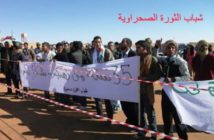An embattled al-Qaeda may quit South Asia to make a fresh start in North Africa.
By Jemal Oumar in Nouakchott and Essam Mohamed in Libya for Magharebia
![[AFP/Mahmud Turkia] A Tripoli protester on August 26th carries a sign reading: "Libya isn't Afghanistan".](http://magharebia.com/cocoon/awi/images/2012/09/07/120907ReportagePhoto1.jpg)
[AFP/Mahmud Turkia] A Tripoli protester on August 26th carries a sign reading: “Libya isn’t Afghanistan”.
These are strange times in the Sahel-Sahara.
Within just the past fortnight, al-Qaeda splinter group MUJAO executed an Algerian hostage in Mali, salafists linked to the previously dormant “Army of Assad Ibn Fourat” attacked a Tunisian hotel, Islamists accelerated their assault on Touareg civilians in Mali, extremists bulldozed and bombed Sufi shrines in Libya and high-level terrorists were caught in the southern Algerian desert.
African and western diplomats and local analysts have used the term “Afghanisation” to describe what is happening in the region. Some argue that al-Qaeda central has shifted its centre of gravity from the Mashreq to the Maghreb.
Attacks against Sufi shrines in first Mali, and now Libya, can only confirm fears that Osama bin Laden’s ideological heirs have found a new home.
In a region that mostly follows the Maliki rite, the wave of unexplained violence has been especially puzzling.
The world was shocked last May when Ansar al-Din attacked and burned the tomb of one of Timbuktu’s saints. But the destruction of Mali holy sites by Islamists and their al-Qaeda allies came amidst other, even more hideous violence in the Azawad region.
Similar desecration of Sufi shrines in Libya three months later, however, seemed to come out of nowhere.
A cleric in Tajoura confirms suspicions that the philosophy behind such behaviour is not grown in North Africa.
“Those radicals don’t care about Libya’s security and stability,” says Sheikh Waleed. “They just import ideas from Saudi sheikhs, such as Rabee al-Madkhali,” he says. “They are even called the ‘Madkhaleen,'” he adds.
Abdelrahman al-Gharyani, Libya’s general mufti, on August 25th denounced the attacks in the sites, saying: “What people are now doing in terms of digging up old graves and demolishing mosques is contrary to the Sunnah.”
“There were non-Muslims’ graves in Medina and other Muslim cities that were conquered, but neither the Prophet nor any of his companion issued orders for their removal,” the mufti added.
Religious extremism, alliances between Islamists and armed terrorists, a population in fear: this has all been seen before. The issue now is what this means for the entire region.
[AFP/Romaric Ollo Hien] Fighters from al-Qaeda splinter group MUJAO watch Gao airport on August 7th. Al-Qaeda central is reportedly shifting operations from Afghanistan to North Africa.
“Only time will tell if Arab North Africa manages to get its act together before it has an ‘Afghanistan-next-door’,” former Tunisian cabinet minister Oussama Romdhani editorialised July 22nd inMiddle East Online.
French Foreign Minister Laurent Fabius was also famously quoted as saying in July about the Mali crisis: “We have already had an Afghanistan and we should not have a Sahelistan.”
Observers of al-Qaeda and its wings in Yemen, Somalia and elsewhere note a new reality for the terrorist organisation. After Osama bin Laden’s death and the start of Ayman al-Zawahiri’s succession, al-Qaeda began shifting its centre of gravity from Afghanistan to the Maghreb region.
This change in orientation was the result of careful planning and guidance by al-Qaeda’s top leaders, especially Ayman al-Zawahiri, who hinted that his fighters needed to find suitable places to engage in jihad, terrorism analyst al-Moukhtar al-Salem tells Magharebia.
“Terrorists got the message,” he says. “In light of the crippling drone strikes and arrests by intelligence agencies, they realised that would be no longer able to move in East Asia,” he adds.
“Therefore, the more suitable alternative was the Arab Maghreb, or more precisely, the region extending from Libya to northern Mali, southern Algeria and Mauritania,” al-Salem explains.
The new pattern of behaviour by Islamist extremists in Libya and northern Mali “doesn’t leave any room for doubt that al-Qaeda is seeking to make its expansionist project a success in the Taliban way, such as the demolition of shrines and the application of its own interpretation of the Islamic Sharia”, he says.
“There are strong indicators proving this shift of al-Qaeda’s centre of gravity from the Asian Mashreq to the Arab Maghreb and its dependence on branches,” says the head of the Millennium Centre for Media Studies in Nouakchott.
According to Said Ould Habib, al-Qaeda Central was damaged by attacks by military forces in Afghanistan and Pakistan. But the organisation recognised a peculiarity of northern Mali and many parts of the Arab Maghreb that made the area a viable alternative.
“Many among the local populations do not have deep knowledge of Islam,” Ould Habib tells Magharebia. “This was the same thing with the Pashtun tribes in Afghanistan and Pakistan, and therefore, al-Qaeda took advantage of this to spread its own extremist concept of religion in the mentalities of those communities.”
“In this way, al-Qaeda spread its extremist culture, and recruited many residents of those areas.”
Al-Qaeda also “raised the banner of jihad” to motivate young people from Somalia, Nigeria, Afghanistan and Pakistan to move to Libya and northern Mali.
[AFP/Mahmud Turkia] The ruins of the Al-Shaab Al-Dahman mausoleum in Tripoli, shown after Islamists bulldozed the building on August 25th, 2012.
“Ayman al-Zawahiri and top al-Qaeda leaders tried to justify the move by saying that the justifications for jihad had started to disappear from the Mashreq and appear in the Maghreb,” the research centre chief adds.
Another reason for the move of global terrorists from Afghanistan to North Africa, especially the vast Azawad Sahara, is geography.
After all, Ould Habib says, the region’s rough terrain is like Afghanistan – just without the mountains.
The diminution of the parent al-Qaeda organisation has been a boon for al-Qaeda in the Islamic Maghreb (AQIM). It moved from being an outpost branch to a pivotal force, thanks to financial independence earned with ransoms for western hostages.
“This gave them the audacity to apply Sharia and disseminate the message of jihad,” terrorism analyst Yacub Ould Ahmed al-Salem says.
“That sense of victory encouraged extremist movements to appear in public in Libya and Tunisia,” Yacub added. “In Libya, they even dared engage in the same practices as Islamist groups in northern Mali, such as the demolition of shrines and religious landmarks.”
The justifications given by extremists for destroying Sufi shrines in Libya were the same as those given by extremists in northern Mali, Le Monde noted on August 28th.
“This behaviour clearly reflects the nature of relations to Islam as seen by extremists in northern Mali and Libya,” Othman Abdelmalek al-Touaregi tells Magharebia. “The difference between the two groups is that extremists in Libya are living in an existing state.”
“The emirate in northern Mali, however, is a new version of the alliance between the Taliban and the parent al-Qaeda,” al-Touaregi adds.
.






